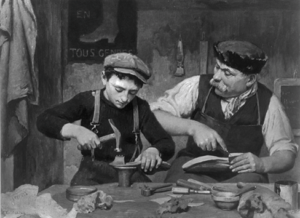The question captured in the title, what in the world are we doing, has two meanings, and both will be explored over the next year at this blog site through invited commentary, providing descriptive models with methods to address particular problems. In addition, this site will post interpretive and subjective narratives about what may be missing in the interactions of applied behavior analysts responding to conditions inside organizations.
Emphasizing “what are we doing?” reflects an absence of clarity, even as we do well-researched and easily understood work obtained from other settings and repeated throughout the literature. Doing well-researched and understood work is not always the same as doing what is needed.
Emphasizing “what we are doing” allows us to explore the expansiveness of a behavior analytic reach and voices of behavior analysts that help expand our view of what is possible. There is much that we are doing right—and doing well.
Well understood by the practitioner, organizational work with individual behavior explores direct and indirect contingencies, the environmental architecture surrounding and influencing the performance.

What resides in every organization is a behavioral tapestry rich with the material needed by behavior analysts to assess and affect change—a visual treasure trove of interactions based on signals in the environment that influence the performer, containing rules of conduct established to lead to predictable outcomes, and unique cultural language, intended to shape and guide particular success. All these elements are part of organizational behavior, including what the behavior analyst brings into the setting that influences performance outcomes unique to specific settings. All these elements tell a visual story or, in this analogy, weave a pattern understood as a detailed behavioral roadmap loaded with contingent relations within a structure that helps or hinders outcomes.
In 2012, Dr. Dwight Harshbarger, in defining organizational behavior management, provided his vision of what we might yet become, writing in private correspondence to this author, “Imagine an input-throughput-output model embedded in a complex architecture rising above and around behavior—architecture that structures and shapes flow, creates and limits possibilities and outcomes. Behavior is always moving, morphing … traveling forward, continuing. The conditions surrounding behavior are found in that three-dimensional architecture, the structure and flow surrounding an individual’s behavior in a particular moment.” Suppose we take that quote and its implications seriously. In that case, we need to add to our behavioral repertoire the decided skill of looking up and around, beyond particular behavior, to address what produces necessary and potentially more lasting effects.
When we do that, becoming familiar with what is maintaining our clients’ behavior, we need to look at that environment as another significant operating source that influences us as behavior analysts employed to address needs. Remember, behavior morphs, changes, and is in perpetual motion. We are behaving. Our behavior morphs.
Looking at what is—in the moment.
Deeply entrenched inside a behavior-analytic worldview is the notion that what is occurring now is what is. We are what we do. That may seem so dull and dismissive of all the exceptional learning we have acquired over our lifetime. That learning is carried forward with us into the present. Still, it does not exist in some distant past, and we are not stuck with any particular behavioral history tugging at us from that past, whether learned at our mother’s knee or not. When going into organizations to examine behavior, we have an invitation to see what is happening behaviorally at the moment. Looking at behavior in such a way allows us to see our science’s promise—that behavior is highly flexible and adaptable and that we all learn anew daily. Conditions can be arranged to help or hinder us. As behavior analyst Ryan Walz observed, “The distinction between history accompanying us from context to context as a condition of how we will behave produces an explanatory fiction, rooted in events distant and removed from the current conditions. Such a belief about our learning histories does little to help us change conditions or actions toward adaptive behavior that is right here, before us, in the present.” While strong feelings and expressed thoughts about the past are not to be ignored, the root of change is, as Ryan says, learning new ways to address those feelings and thoughts in the present where change happens, to stay in the present to address all these very complex perspectives about who a person is and what that person does.
As a discipline, consider that:

- Our effects are robust—but can be transitory or assessed as trivial or routine. Do we work to evaluate what might make it stick a bit more?
- Current behavior is not in our history but in the present, the morphing of behavior into new and sometimes beautiful patterns.
- We do what we know to do persistently, often accompanied by high degrees of positive reinforcement. We master skills to habit-strength. Looking Up to learn new variations to improve our skills is difficult.
- Our science adds clarity to the whole of the human condition, and yet, our well-researched and impactful efforts are often invisible in the larger culture of change.
Science advancing the human condition.

A behavior analyst is often best known outside our discipline for exception management in the supportive development of skills for those most in need to live lives that allow for choice and flexibility. Inspiring and, at times, breathtaking in reach, such work is sometimes dismissed as having no particular significance beyond the exception, the problem in adaptation and learning. The depth of scientific exploration to ensure the work is done in helpful ways is not always known. Behavior analysts are often viewed as problem fixers, technicians, and not behavior-environmental architects, steeped in science, with skills to address cultural changes needed to ensure better policy and practice alignment, with designs and applications that can help maximize each human’s condition.
Real-life cases of organizational applications will be examined, where bias and science come together, including when bias, not science, sometimes wins. Exploring the values that shape our work, including the much-discussed striving to do work of social significance in addressing human behavior, helps us define what we are doing or failing to do.
Do we have an obligation when changing other people’s behavior to examine and perhaps change our own? What do we bring to the party except our science and the skills of scientific application? How do we inoculate ourselves when in the presence of a significant reward to avoid doing something other than promoting, broadly speaking, the social good? When given the privilege of arranging conditions to help a person or group change, that question is a necessary beginning point for us all.
Jon Krapfl, my first boss in what was for me then a new world of business consulting, reminded me of that when I first entered organizations. “You are immediately influenced by the settings you enter. Be vigilant in how you interact. Don’t become a part of the problem. Always tell it as you see it in ways others can hear.” That advice, provided in 1986, was captured in my journal as I began doing OBM work. It is, to this day, an ever-present mantra.
Mentorship: A lifetime of learning

Advice will be shared throughout the blog series from the work and words of behavior analysts who have influenced me on the organizational side of my work, like Don Hake, Linda Hayes, Israel Goldiamond, Jon Krapfl, Murray Sidman, Thomas Gilbert, Aubrey Daniels, Francis Mechner, Bill Abernathy, Ronnie Dietrich, Pat Friman, Carl Binder, Tom Freeman, Cloyd Hyten, Adam Hockman, Sigrid Glenn, and Andy Lattal, to name a few. They, and others, have had a significant hand in shaping and reinforcing what I am still striving to do today—mentors all. Identifying mentors’ principles and practices seems a good thing to do as a new practitioner or an old salt. I found keeping a record describing my mistakes, specific comments, or example-based advice critical to my evolving views about behavior analysis helpful.
Our biases and limitations
What causes the practitioner –you and me– to attend to conditions beyond the target behavior and modify practices surrounding the subject and ourselves? What is embedded in our training to see that? Why do we do this work? Do we work as organizational behavior analysts to
- reflect the values of our society (for good)?
- promote behavioral independence, observable and measurable, building rich and generative responses across conditions?
- Influence change (context) beyond the immediate and specific tasks assigned?
For most of us, saying no to these broad-based values statements is unlikely. After all, a tenet of our discipline is to engage in what we define as socially significant work. If you say yes to some or all of these reasons, consider describing how they appear in what you say and do. Are they known to others as central to your approach?
Seeing our target as “other people’s” behavior is insufficient to establish directional approaches to produce future impact. What do we measure immediately and over the longer term when we change behavior? How have we been trained to “see” and address the broader social significance of everyday workplace issues? What should we measure about our effects as part of how we work?
Stay tuned; hopefully, you and others will add to this dialogue, helping us see new ways to advance our science and applications in our organizations.
PHOTO CREDITS
Photo 1 – Blurred people: Unsplash – Martin Adams
Photo 2 – Dancer: Unsplash – Ahmad Odeh
Photo 3 – Child with a robot: Unsplash – Andy Kelly
Photo 4 – Repro. of painting by (Louis-?)Emile Adan (1839-1937), copyrighted by Braun & Co., N.Y., Public domain, via Wikimedia Commons [apprentice: Wikipedia https://commons.wikimedia.org/wiki/File:Apprenticeship.jpg.]
Blog post contributed by Darnelle Lattal.
